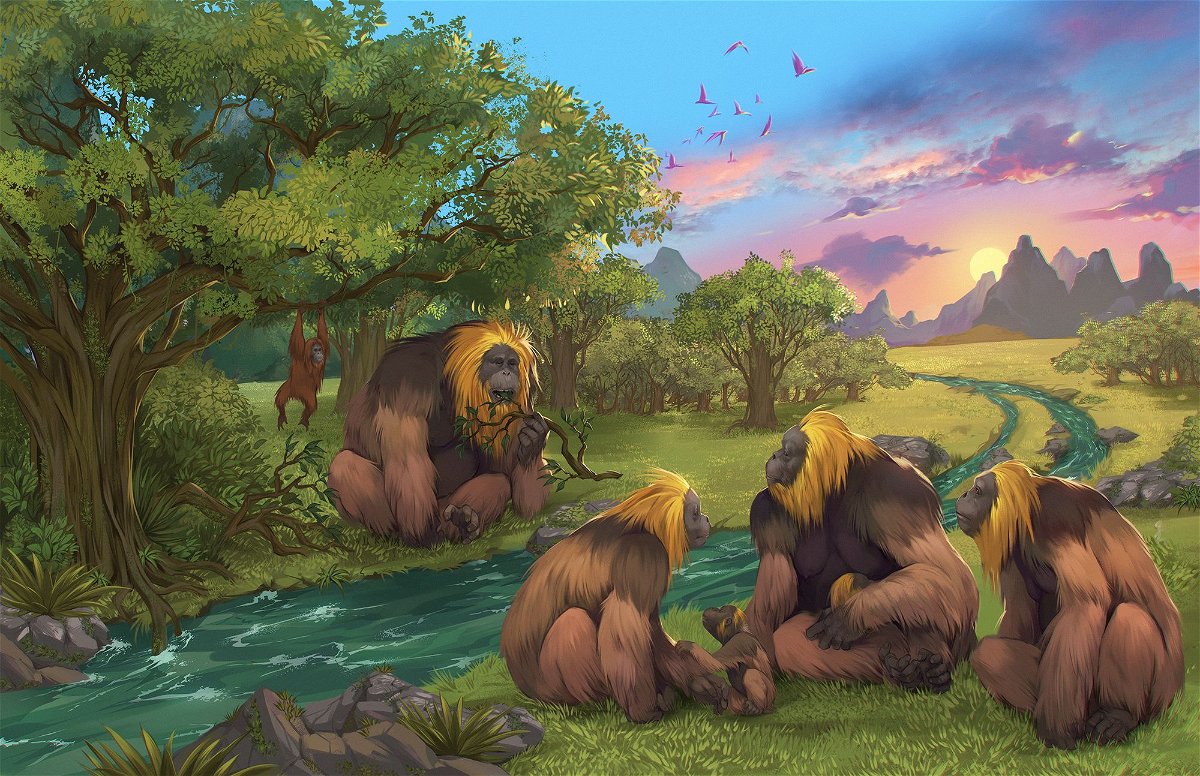A King Kong-like ape once roamed southern China. Scientists say they now know why and when it disappeared

By Katie Hunt, CNN
(CNN) — The largest ape on record stood almost 10 feet tall (3 meters) and weighed nearly twice as much as a gorilla. Why and when the legendary colossus — which has captivated the popular imagination as “the real King Kong” — disappeared is one of the biggest mysteries in paleontology.
German-Dutch paleontologist G.H.R. von Koenigswald first identified Gigantopithecus blacki about a century ago from large teeth sold as medicinal “dragon bones” at a Hong Kong apothecary. Some 2,000 fossilized teeth and four jawbones from the extinct species have since been unearthed in caves in southern China.
Now, new research on many of these rare fossils and the caves where they were found builds on preliminary evidence, revealing a timeline that sheds more light on the elusive circumstances surrounding the demise of Gigantopithecus.
“I think the child in us wants to know about these amazing creatures and what happened to them,” said Renaud Joannes-Boyau, a coauthor of the study published Wednesday in the journal Nature. Joannes-Boyau is a professor in the faculty of science and engineering at Southern Cross University in Australia.
The authors believe the massive creature went extinct between 295,000 and 215,000 years ago, after the climate became more seasonal and the plant-eating primate struggled to adapt to changing vegetation.
Before Gigantopithecus populations dwindled due to climate change, the species flourished starting from about 2 million years ago in a rich and diverse forest environment, primarily eating fruit, said study coauthor Kira Westaway, a professor and geochronologist at Macquarie University in Australia.
“Around (700,000 or) 600,000 years ago we start to see large environmental changes and during that period we see a decline in the availability of fruit,” she explained.
“Giganto (ate) less nutritious fall-back foods. We’ve got evidence from looking at the teeth structure,” Westaway added. “Pits and scratches on the teeth suggest it was eating really fibrous food such as bark and twigs from the forest floor.”
Detailed timeline
Over the course of nearly a decade, the team of Chinese and Australian scientists took sediment samples from 22 caves over a wide area of the Guangxi region in southern China that borders Vietnam. Half of the caves contained Gigantopithecus fossils, while half did not.
First, the researchers obtained accurate dates for the fossils and the sediment using several techniques. Luminescence dating revealed when sediment was last exposed to sunlight and deposited in a cave, and U-series dating pinpointed when uranium was taken up into bone specimens after the animal died. This analysis helped the team put together a detailed timeline of the species’ existence.
“The early caves at 2 million years old have hundreds of teeth, but the younger caves around the extinction period — there are only 3-4 … teeth,” Westaway said.
Next, the team analyzed pollen traces in the sediment samples to understand what plants and trees dominated the landscape. Isotope analysis of elements such as carbon and oxygen contained in the Gigantopithecus teeth helped the researchers understand how the animal’s diet may have changed over time.
The team found that the giant ape did not adapt well to changing environmental conditions and displayed chronic stress and dwindling numbers, Westaway said.
“We have a much more robust timeline for their life and when they went extinct — rather than being based on evidence from one or two caves, we have sampled 22 caves over a wide area and employed six dating techniques to make sure that the timeline is accurate,” she said.
Questions remain
No Gigantopithecus fossils from the neck down have ever been found and documented. Given that Gigantopithecus roamed parts of Asia for some 2 million years, Westaway said that was surprising.
The giant apes never lived in caves, according to the authors. It’s thought that rodents carried their remains into them, often through small rock fissures in the region’s distinctive rocky karst terrain, said study coauthor Wang Wei, a professor at Shandong University’s Institute of Cultural Heritage in Qingdao, China.
“The teeth or mandibles of great apes (based on the fossil evidence that has been found) went through an extremely complex process of death, decomposition, weathering, transport and deposition before they were embedded in cave sediments,” he explained via email.
“As a result, only a very small number of the hardest parts of Gigantopithecus’ body would have become fossils during geological history.”
Given the lack of non-cranial fossils, it’s hard to know exactly what Gigantopithecus would have looked like. Its upper molars are 57.8% larger than a gorilla’s and the lower molars are 33% larger, suggesting its body weight would have been 440 to 660 pounds (200 to 300 kilograms).
The ape’s mammoth size indicates that it most likely lived on the ground, walking on its fists. A November 2019 analysis of proteins found in a Gigantopithecus fossil suggested its closest living relative is the Bornean orangutan.
Homo erectus, an early human ancestor, is known to have lived in northern China and farther south in Indonesia at the same time the giant ape lived in forests of what’s now southern China.
Wang noted that at the Bose Basin, near a cave where Gigantopithecus fossils were found, archaeologists have uncovered a large number of stone tools dated to about 800,000 years ago. While scientists have no direct fossil evidence of H. erectus and the giant ape coexisting in the region, it was possible that these human ancestors may have had an encounter “with the big guy,” he said.
The-CNN-Wire
™ & © 2024 Cable News Network, Inc., a Warner Bros. Discovery Company. All rights reserved.